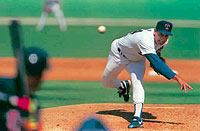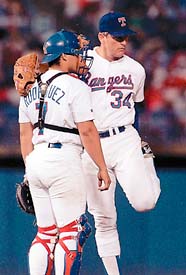 |
|
Reflections of glory Emotions sure to run deep as Ryan joins Hall 07/25/99 By Ken Daley / The Dallas Morning News
On Sunday, the most treasured memory of all will be added. Ryan's plaque will be unveiled inside the National Baseball Hall of Fame and Museum in Cooperstown, N.Y. "It's very scary," warned Hall of Famer Henry Aaron, baseball's all-time home run king. "The closer to it you get, you start to think about who stood on that podium before you. You wonder if you really belong, no matter what you've done. "But it's a great feeling. You feel like, after all the years you played, you finally made it to where everybody would like to be."
That Ryan was destined to stand among baseball's immortals has been conceded for years, even if the man himself says he rarely considered it while playing. "I wasn't one to compare myself to other players or think that I would be thought of in that light," Ryan said. "It's a realization that a lot of people look at you that way. But I'd much rather be introduced as a Hall of Famer rather than a future Hall of Famer. I never was too comfortable with that." Until now, there was no other way to label Ryan. The skinny kid from Alvin who signed with the New York Mets in 1965 for a $12,000 signing bonus, plus $500 a month, became the stuff of Texas legend. He worked with such drive, durability and competitive spirit that he was able to pitch effectively for the Rangers to within four months of his 47th birthday. His talent, and the sheer weight of the numbers it produced, boggle the mind. There were 5,714 strikeouts, 1,578 more than any other pitcher ever recorded. One could combine the strikeout total of runner-up Steve Carlton (4,136, the only other man to strike out more than 3,800 batters) with that of Pedro Martinez (1,408 as of Wednesday) and still fall 170 shy of Ryan's strikeout tally. There were 324 wins, tied for 12th on the all-time list with Don Sutton. Cy Young Award winners Tom Glavine and Randy Johnson have combined for only nine more victories than Ryan, despite pitching for far better teams during their careers.
By the time a torn elbow ligament ended his career, on Sept. 22, 1993 in the first inning at Seattle, Ryan had played longer than any player in major league history. That distinction is one of 48 major league, National League or American League records that Ryan shares or owns outright. "It's been my life," said Ryan, an eight-time All-Star. "I guess, when you think about paths that your life takes, it wasn't something that I set out to do. . . . You walk in the Hall and see the plaques and displays of all the great players like [Babe] Ruth, [Lou] Gehrig, Cy Young, Walter Johnson and those guys. And they tell you where your plaque is going to hang, and you realize you're going to be thought of on that level. "It makes you feel real good, because you always held those people and what they accomplished in a very special place." Ryan, George Brett, Robin Yount and Orlando Cepeda are the four living members of this year's seven-member induction class, the Hall's largest since 1972. The emotional impact of induction weekend will affect each in different ways. "I think that's a determination they will make," said Hall of Fame pitcher Warren Spahn, 78, the winningest lefthander in baseball history. "All of us in the Hall of Fame welcome them with open arms. They're joining a very special group of people. "It's a terribly important thing, a very special time." Hall of Fame pitcher Jim Palmer, a 1990 inductee, remembers the experience as "nerve-racking," particularly the Saturday night banquet open only to Hall members. "It's a very emotional time, because of how many living Hall of Famers will be there," Palmer said. "When you go to the dinner, that's the first time you realize how close of a fraternity it really is. You really get an idea of what it's like when you get to meet all the other living members. It's a special time." Ryan usually controlled his emotions better than his fastball, but even he is unsure whether he will manage to maintain dry eyes this weekend. "Well . . . it has the potential to be [emotional], that's probably the best way to put it," Ryan said. "I was talking to George [Brett], and he said he's been thinking about what he's going to say. He said, 'You know, I'm an emotional person.' I think he's concerned that once he gets up there and starts reflecting on his career and what people meant to him, it will become very emotional. "I think that's a natural tendency when you reflect on people who have been very dear to you in your life. I guess we'll just see."
"The first few years," Ryan said, "I remember thinking, 'Hey, I made the big leagues. If I can get four years in and qualify for the pension, that's all I want.' "Then it came to me, when I was pitching for the Angels and started getting consistent: 'Hey, I have a neat opportunity here. And when I walk away from the game, I want to say that I gave it everything I could to be the best player I could.' " Ryan didn't cheat teammates, fans or himself. His career began with a tumultuous seven years in the Mets' organization. After he was discovered and signed by Mets scout John "Red" Murff as a 155-pound string bean out of Alvin High School (20 minutes outside of Houston), Ryan quickly gained a reputation with his overpowering fastball. He struck out 445 hitters in 291 minor league innings, but suffered from recurring arm soreness that frustrated Ryan and the Mets. It wasn't until 1968 that Ryan stuck with the Mets for the first of four full seasons in New York. Manager Gil Hodges told reporters that April: "All I can tell you is that boy has a great arm. I had heard about it, but I had never seen it. Now that I have, I believe it." And just two months later, Hodges had seen enough of Ryan to predict, "He could break all the records before he's through." Ryan earned a save - and his only championship ring - with the Mets in the 1969 World Series. But a weekend military commitment prevented him from working consistent innings in a Mets starting rotation that also featured Tom Seaver, Jerry Koosman and Gary Gentry. The Mets finally dealt their still-wild righthander, along with three minor leaguers, to the California Angels for run-producing infielder Jim Fregosi on the last day of the December 1971 winter meetings. Even then, Hodges was apprehensive about giving up Ryan. "Whether or if or how he's going to do it, I don't know," Hodges said. "But he's got ability." And it was in California where that ability began to manifest itself fully. Ryan's military reserve duty was over, and he found an understanding instructor in pitching coach Tom Morgan. Ryan began pitching in a regular rotation for a weak team, one with little choice but to afford him the innings that he needed to develop. Ryan blossomed over eight seasons with the Angels, pitching four of his no-hitters there and winning 138 games, still second on the franchise's career list. He remains the most popular player in Angels history. "The two organizations that impacted my career the most were the Angels and the Rangers," Ryan said. "I really consider my years with the Angels as the foundation of my career. That's where I really accumulated innings, established myself as a power pitcher, and some very neat things happened there. I think pitching for the Angels when I did probably made me a better pitcher, because I didn't have a lot of run support to work with." Ryan became eligible for free agency for the first time after the 1979 season. When Angels general manager Buzzie Bavasi took a hard-line salary stance, the Houston Astros offered Ryan the chance to return to his home state, with the distinction of becoming baseball's first $1 million-per-year player. Ryan accepted. Bavasi, noting Ryan went 16-14 in 1979, shrugged off the departure by saying Ryan could be replaced by a couple of 8-7 pitchers. It wound up being a statement that inspired Ryan, haunted Bavasi and to this day rankles longtime Angels fans. Ryan pitched a record-breaking fifth no-hitter and made his final three playoff appearances during his nine seasons in Houston, where he won 106 of his 282 starts. But when his contract was up after the 1988 season, Astros owner John McMullen offered a 20 percent pay cut to Ryan, then 41. Ryan, assured by longtime Texas pitcher Charlie Hough that he could handle the North Texas heat, signed with the Rangers instead. "Because of Buzzie and John McMullen, two of the darkest days of my life turned out to be two of the best things that ever happened to me," Ryan said. "I would have never ended up in Houston if Buzzie had taken any other position, because I would have stayed and played for Gene [Autry, the Angels' late owner]. And if it wasn't for John McMullen wanting to cut my salary 20 percent to make an example out of me for baseball, I wouldn't have ended up here." And Ryan's years with the Rangers provided the setting for some of his most crowning achievements. "When I came here with the Rangers, I came with the intent of staying one year," Ryan said. "And I stayed five, because I enjoyed it so much." Ryan was in a Rangers uniform when he won his 300th game, struck out his 5,000th hitter and pitched his sixth and seventh no-hitters. "The Rangers gave me that opportunity to come up and play, and they left it up to me how long I wanted to play," Ryan said. "I felt like, because of the attitude and support they gave me, it allowed me to take my career to another level." And so Ryan will become the first player to wear a Rangers cap on his Hall of Fame plaque. It's the final chapter of a glorious career and a remarkable association with the final team for which he pitched. "I feel very blessed," Ryan said. "I feel like God gave me a talent to throw a baseball. And then it was for me to make the best of it." |
|
Send us your feedback. |



